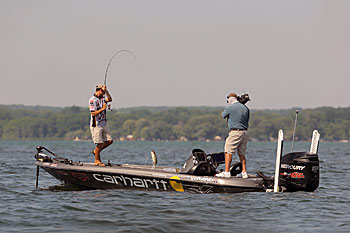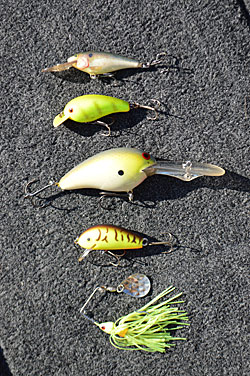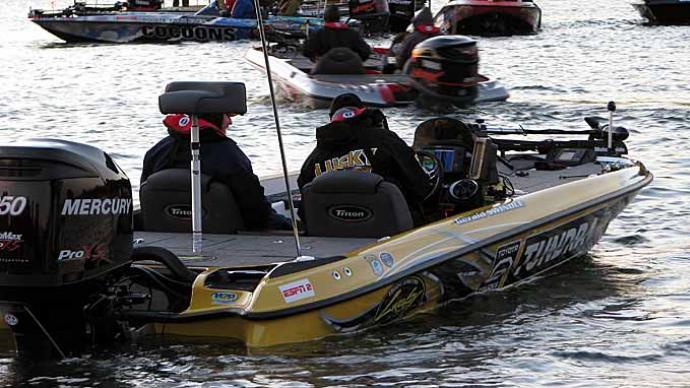
Be versatile—Fish the moment. Match the hatch. Bass anglers follow these words of wisdom regardless of where they fish. When fishing is tough, they follow one more piece of advice: Switch to finesse techniques.
If your finesse fishing starts with a shakey head and ends with a drop shot, you’re missing out on presentations that can put bass in your boat. That’s because finesse fishing is more of an attitude than a specific technique. It’s about adaptation. Sometimes that means throwing finesse lures in new places. Take Jordan Lee’s run at winning a 2016 Bassmaster Elite Series stop at Cayuga Lake in Upstate New York. He pitched a drop-shot rig into heavy grass. That option has been explored with heavier tackle but not as much with the spinning rod he was holding.
Finesse fishing also is about finding lures that catch bass under the most demanding conditions — cold fronts, heavy fishing pressure, and bass keying on a specific size or type of prey. Power-fishing lures are known for their large sizes and speedy retrieves, which often include crashing and bashing through the cover. But change your perspective, and they can be as effective when finessed. Like you downsize from an 8-inch worm to a 4-inch one, you can downsize your power-fishing lures. Finesse versions of jigs, crankbaits, jerkbaits, spinnerbaits, and even less popular styles of soft plastics will generate bites under challenging conditions. Yet, not many anglers are using them.
These finesse lures catch big bass, but they are better at generating numbers of strikes. That’s especially helpful during a tough tournament when even a small limit will push you toward the top of the leaderboard. Quantity over quality also is essential when introducing someone to fishing. It helps them quickly gain confidence and sustain interest.
Jigs
Jigs are the most versatile bass lure. Shallow or deep, cold or warm, open or filled with structure and cover, there is no water where a jig won’t work. While bulky ones that weigh between ½- and 1-ounce catch their fair share from heavy cover and deep water, smaller ones that weigh 1/8-, 3/16- or ¼-ounce, such as Strike King’s Bitsy Bug, are tough to beat when a finesse presentation is needed.
Finesse your retrieves as much as the size of your jig. You want it to look realistic and non-aggressive so it doesn’t turn off bass. Use slow, soft movements of your rod’s tip to bounce it along the bottom. Its light weight makes it slowly sink, so it’s perfect for swimming through the mid-depths.
Try shaking it as it falls to entice suspended bass around and under cover, such as floating docks and their posts.
The right trailer will make your finesse jig work better. Avoid ones that require a lot of movement, such as double-tail grubs. These light-weight jigs aren’t heavy enough to achieve the speeds they need. You’ll be better off with a gliding trailer such as a Zoom Super Chunk Junior or cut-down 4-inch Gene Larew Salt Craw. Try a more realistic soft-plastic craw in gin clear water, complete with pinchers and antennae.
Don’t throw finesse jigs on your stiffest flipping stick and 65-pound braid. Move down to a 7-foot medium-action casting rod. There will be enough length for you to pitch the jig around cover and surely set the hook. Downsize your line to 15-pound monofilament, fluorocarbon, or spool 30-pound test braid.
Finesse jigs aren’t always tied with living rubber. Bucktail and marabou jigs also are great choices in tough conditions. They are quiet, and the natural fibers move even when the jig sits still, adding action that can make inactive bass bite. Several of the top competitors at the Bassmaster Elite Series event on the St. Lawrence River used lightweight marabou jigs to catch giant post-spawn smallmouth. Slightly heavier bucktails have become a staple for ledge fishing, especially when heavily pressured bass turn up their noses at big crankbaits, flutter spoons, and Carolina rigs.
Crankbaits

The water temperature was right, and so was the level. Largemouth filled the pocket, boiling the surface while chasing shad. I fished down the bank, from one laydown to the next, casting a ½-ounce spinnerbait sporting a large Colorado blade and bulky trailer. The bass wouldn’t touch it. Getting frustrated, I saw a school of shad, each no bigger than half of my thumb. Just as the school disappeared from view, three bass cut through it.
I cut off the spinnerbait and tied on a Bandit 100 crankbait, which is no more than 2 inches long. I could have picked a small Cotton Cordell Big 0 or a No. 5 Rapala Shad Rap. Over the next 20 minutes, I caught a dozen bass, including several on back-to-back casts, all from the same stretch of bank that produced nothing with the spinnerbait.
While big crankbaits are suitable for grinding deep ledges and ripping around shallow cover, there are places for small crankbaits, especially when bass key on small baitfish. It can be a smart move when the water is at its coldest. The Shad Rap’s tight wobble keeps it tracking near cover, such as rocks, making it an easy target for inactive bass.
Smaller crankbaits require a special retrieve. Bass prefer them to be swimming along, so it’s less critical for them to bounce off the cover, as you do with bigger models to create reflex strikes. Stop-and-go retrieves generate a wounded action that draws strikes. That can be accomplished by stopping your retrieve at various points or sweeping your rod. The crankbait pauses while you retrieve the slack and move your rod back to start the next sweep.
Small crankbaits need light gear. They can be tough to cast, and their small hooks can bend and pull out with too much pressure. Use a light action casting rod and super-smooth reel spooled with 8-pound test monofilament or fluorocarbon line. They’ll cast easier with the same line on a spinning rod.
Jerkbaits
If you look up spawning cove in the dictionary, there would be a map of this spot. The cove narrowed where it met the main lake, leaving just enough room for a well-defined creek channel to wind its way through and toward the back. There a shallow flat lined with docks and filled with hard bottom was protected from cold spring winds, regardless of direction.

My partner and I weren’t the only tournament boat to fish it this early spring weekend when the water was cold and the skies clear. On the first morning, it was shared by anglers throwing everything from jigs to full-size jerkbaits. Plenty of bass were caught, but not as many as were hooked on the small jerkbaits — about 3.5 inches long with two treble hooks — that we were casting.
Jerkbaits measuring 4.5 to 5 inches long, such as Rattlin’ Rogues and Megabass Vision 110s, are the bass-fishing standard. And some anglers don’t think twice about heaving a big 12-inch glide bait for bass. But when the bite gets tough, the lifelike slender profile of small jerkbaits produce more strikes.
Work them with slow twitches and long pauses, so choose a suspending model regardless of season; usually, they are reserved for cold water. Stick to natural colors such as chrome with black or blue back or rainbow trout, which works well even where that species isn’t found. It doesn’t hurt to pick a jerkbait without rattles.
Small jerkbaits work as topwaters, too. Original Rapalas aren’t often mentioned as bass lures. But quietly twitching a No. 9 or No. 11 over shallow vegetation or around cover can catch plenty of bass in the spring and early summer.
Spinnerbaits
Shallow natural lakes are built to beat the bank. Their shorelines usually are covered with overhanging bushes and lined with rocks, emergent aquatic vegetation, and docks. Those are the perfect places to through a small single-bladed spinnerbait, such as the Strike King Mini King, which is perfect for finessing strikes from inactive bass.
These compact miniature spinnerbaits make them easy to cast to specific targets. That’s good because while their little blade puts out as much thump as possible, it’s not enough to pull bass from a distance. A slow, steady retrieve produces best, and adding a 1-inch curly tail grub makes them bulkier and run more accurately at slightly faster speeds.
The real benefit of small spinnerbaits is how they let you cover water. That’s a necessary means of combating nonaggressive fish. The more water you cover, the slightly more aggressive — easier to catch — bass that you’ll come across.
Little used soft plastics
Canandaigua Lake doesn’t receive as much angling attention as other New York Finger Lakes such as Cayuga and Seneca. That doesn’t mean its bass are smaller or less plentiful. But the smallmouth weren’t in a biting mood on this calm fall afternoon.
They should have been. Clear water and skies were perfect for seeing the baitfish schools nervously swimming about the isolated milfoil beds, each about the size of two 20-foot bass boats. They passed up jerkbaits, double-willow spinnerbaits, and lipless crankbaits. They started biting once we downsized to tiny soft jerkbaits. Shaped like a Slug-Go and about three-quarters the length of your thumb, they were what the smallies, which averaged 4 pounds, wanted.
Soft-plastic finesse fishing is more than 4-inch or shad-shaped worms. Small soft jerkbaits, like those that saved the day at Canandaigua, leaches and reapers are less-used styles that offer something different to inactive bass. Sometimes that sparks their curiosity enough to cause them to strike. You can rig them on jig heads, drop shots, or Texas-style. Keep your weight light — no more than 1/8-ounce — and free sliding. Even a small tube jig, such as those designed for panfish and crappie, can score bass when times get really tough. That’s especially true in the spring when bass first move shallow.
BassResource may receive a portion of revenues if you make a purchase using a link above.




